April 10- 11, 2025
InterAccess
32 Lisgar Street
Toronto ON M6J 0C7
Opening celebration: Friday, April 11, 6-9pm
The works included in this exhibition are representative of students from across our program, Graduate and Undergraduate presented in a wide variety of mediums and formats. From games, web-based, to electronic, to mixed reality, the common thread to most of these works is the computational basis in their conceptualization and realization. Most of the works presented here use content that is generated in real-time using algorithms as their creative toolset. All of the works embody computational thinking and aesthetics in their execution that include systems-based methodologies, hybrid art, and interdisciplinary approaches to making art.
Digital Media is a joint program between Computational Arts (School of Arts, Media, Performance, and Design) and Electrical Engineering and Computer Science (Lassonde School of Engineering) that mixes arts and media with engineering. In the program students use code and programming as tools for creative expression in forms such as immersive and 3D environments, interactive performance, data visualization, games and apps.

DATT 2010: Physical Computing I
Reef Guardian
Adara Hagman
Reef Guardian is a coral-inspired creature. It was created by Adara Hagman during Jane Tingley’s DATT 2010: Physical Computing II class at York University. The Reef Guardian lives among corals to guard them from any threats. Temperature and acidity have been rising in the ocean due to global warming. As conditions change, corals become stressed and start to bleach. When corals bleach they expel algae from their tissues and turn white. Another influence for the Reef Guardian was dragons. Dragons can be seen as a symbol for protection. The Reef Guardian is composed of 3D printed coral plates layered by size to create a dragon inspired shape. Balloon actuators are used to move some of the coral plates for an organic breathing effect. There are LEDs under each plate. The coral plates were printed in a transparent filament with no infill. This allows the guardian to glow when the LEDs are on. There are two 3D printed corals with LEDs underneath symbolizing the coral reef the guardian lives in. When viewing this piece from far away, the corals will be colourful and the Reef Guardian will be in a calm state. As someone moves closer to the coral reef, the Reef Guardian becomes agitated and enters a protective state. Surrounding corals will go into a protective state by turning white, symbolizing coral bleaching.
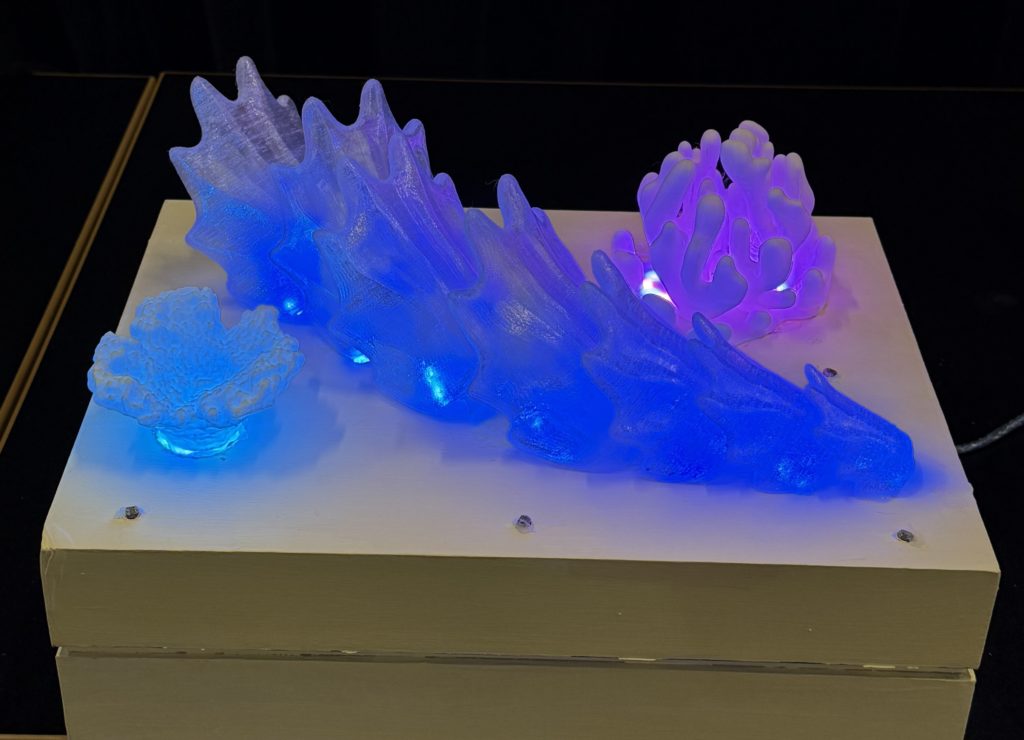
Blobby
Robin Tarnocai
Blobby is a living organism who is currently being socialized. He was created as a fully self-sufficient test subject at a secret government laboratory. Here, Blobby was often neglected leading to a solitary lifestyle and a deep mistrust of humans. Many years ago the lab needed to be shut down, and due to a series of unfortunate events Blobby ended up in a back alley of Toronto. Upon discovering the little blob, a passerby gradually earned Blobby’s trust, and brought him to us. He is made primarily of yarn, and powered by an Arduino uno. When approached cautiously he becomes intrigued —his heart rate briefly slows down and he illuminates. If approached too quickly however he becomes defensive and emits a red glow and a loud growl while shaking violently. You can calm him down after an episode by gently stroking his fur. He prefers to be touched on the grey stripes along his back. However if he is pet too aggressively he will resume a defensive state.
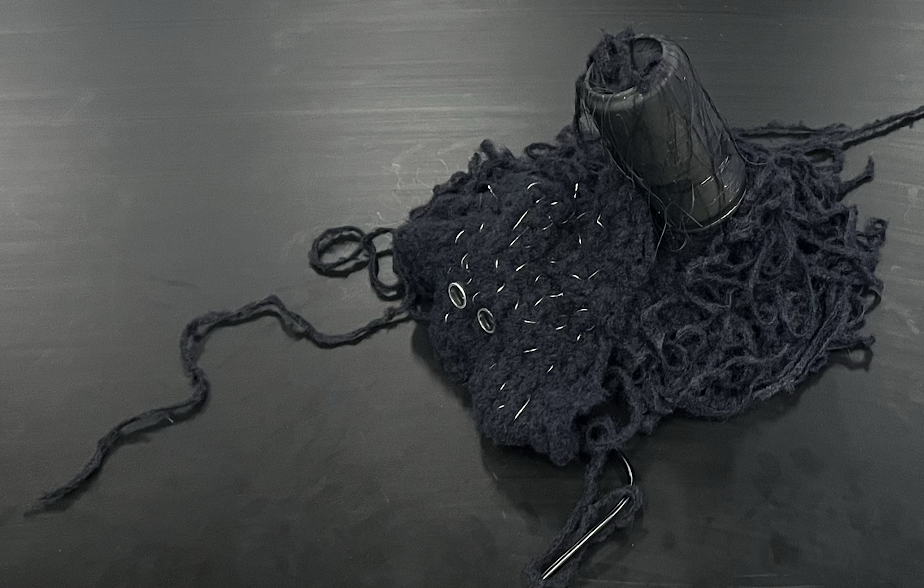
DATT 2040: Math, Art, Code
Fractal Fantasia
Ethan Wu
https://sihwapark.github.io/DATT2040_F24_Select_Works/Fractal_Fantasia/
This project explores the intersection of randomness, recursion, and interactivity in generative art using fractals. The design makes use of previous frames to simulate fractals that repeat throughout the design, featuring dynamic colour transitions, layered recursive transformations, and the ability to adjust the zoom, rotation speed, and background colour. The artwork evolves continuously over time, creating intricate and unique patterns.
Passage of Time
Uday Pal
https://sihwapark.github.io/DATT2040_F24_Select_Works/Passage_of_Time
Passage of Time is a music visualization for the song ‘One More Year’ by Tame Impala which is a song about time passing by and the sentiment around time in general. This work is an audio visual piece that revolves around time and different modes of time. I made a time lapse to sequence the events at specific points in the song and each sequence corresponds to either the lyrics or the general theme of passing time, there are also cursor interactions with some sequences as well.

DATT 2501: Introduction to 3D Animation
Sam Genovese, Cecilia Nguyen, Koury Pereyra, Owen Tarka, Estelle Pat, Nithan Aravinth, Meryl Yeung, Merab Hematinejad-Kermnai, Yiming Yi, Fransisco Altuna, Mark Hinchcliffe, Calvin Tang, Leene Isabel
A sample of student work from Introduction to 3D Animation.
DATT 2310: Game Design and Prototyping II
Musical Escapade
Allen Arciaga, Jennia Deenaraine, Sam Genovese, Ethan Hammah, Lucas Jaramillo, Autumn Pham
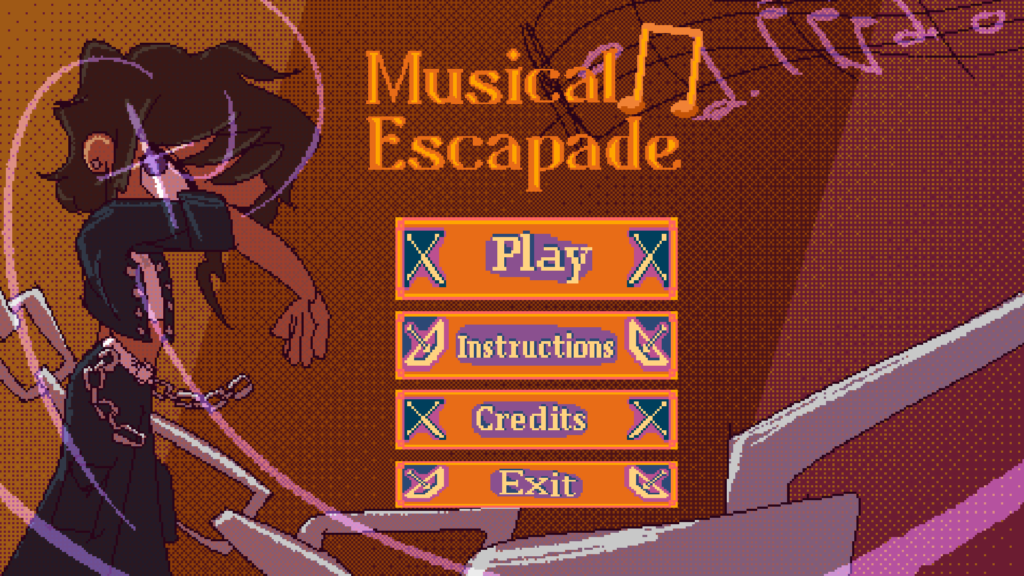
Musical Escapade is a 2D rhythm game with hand-drawn visuals and music produced by our teammate. Immerse yourself in a new world as you play as Cayden, a young musician who’s life was tragically taken by their electric guitar that electrocuted them. In the afterlife, Cayden meets with Death, who tells them they can revive, if and if only they can save a far away kingdom from the dangers that lurk within the realm. Hesitantly, Cayden accepts. As they are transported to this new world, Cayden realizes a shift in their powers and is now capable of using the device that took their life, to combat the monsters wreaking havoc in the new world. Walk through the map as Cayden and play through 5 rhythm game levels and encounter different enemies with different hit points to damage. Be careful though, you may fail in your attempts, but practice makes perfect and you’ll make it to the top!
S.P.I.C.E. Route
Dev Chhetri, Michael Benedik, Ellia Godbout, Ashley Thong, Samuel Ollmann-Chan, Chigozie “Anthony” Duru

S.P.I.C.E Route is a Sci-fi 2D Drag-and-Drop Restaurant Simulator where you play as Chef Vril – an alien that comes from a race who only served as cooks for a large empire – but was never taught to cook themselves, so they are as new to cooking in this alien kitchen as the player. Players will cook unique ingredients – such as human meat – into recipes that suit the alien customers’ dietary needs. Players must strive to cook to the best of their ability, as upsetting customers means less revenue and a damaged reputation. Revenue can be spent on kitchen upgrades, allowing the player to choose which kitchenware equipment they would like to invest in to enhance their cooking experience. Gameplay consists of various “day” cycles, where the player will fulfill as many orders as possible within one day. Serving one customer at a time, the goal is to complete orders as fast as possible – the more orders completed, the more revenue to be earned. The game’s challenge is to avoid mistakes when preparing the ingredients, as the food truck’s reputation is lowered with each faulty dish served, meaning less revenue will be earned.
https://elliag.itch.io/spiceroute
DATT 3074: Creative Generative Audio Signal Processing
RADIO 3074
Tsz Him Ng, Linh Dan Le, Kaidi Chen, Ul Abdin Zain-Ul-Abdin, Robert Jamrocha-Tullo, Abdullah Al Fuad, Rabiha Chowdhury, Arsalan Khan, Hiromune Kubayashi, Emma Su, Luca Iamundo, Michael Barras, Emile Hosein, Santiago Bucio-Cano, Jin Yong Maeng, Ivan Ng, Seila Bak, Hassan El-Gazzar, Mishal Khan
Radio DATT307 is an online radio that can tune into different stations of endlessly generative sound and music. Each station continuously uses the current date & time to manipulate parameters of a unique sonic algorithm to ensure that it sounds different whenever you tune in – mornings are different from evenings, weekends from weekends, as the months and seasons pass. Each station was written by a different student as an assignment in DATT3074 “Creative Audio Signal Processing”, using gen~ and RNBO from Cycling ’74.
https://alicelab.world/datt3074/radio
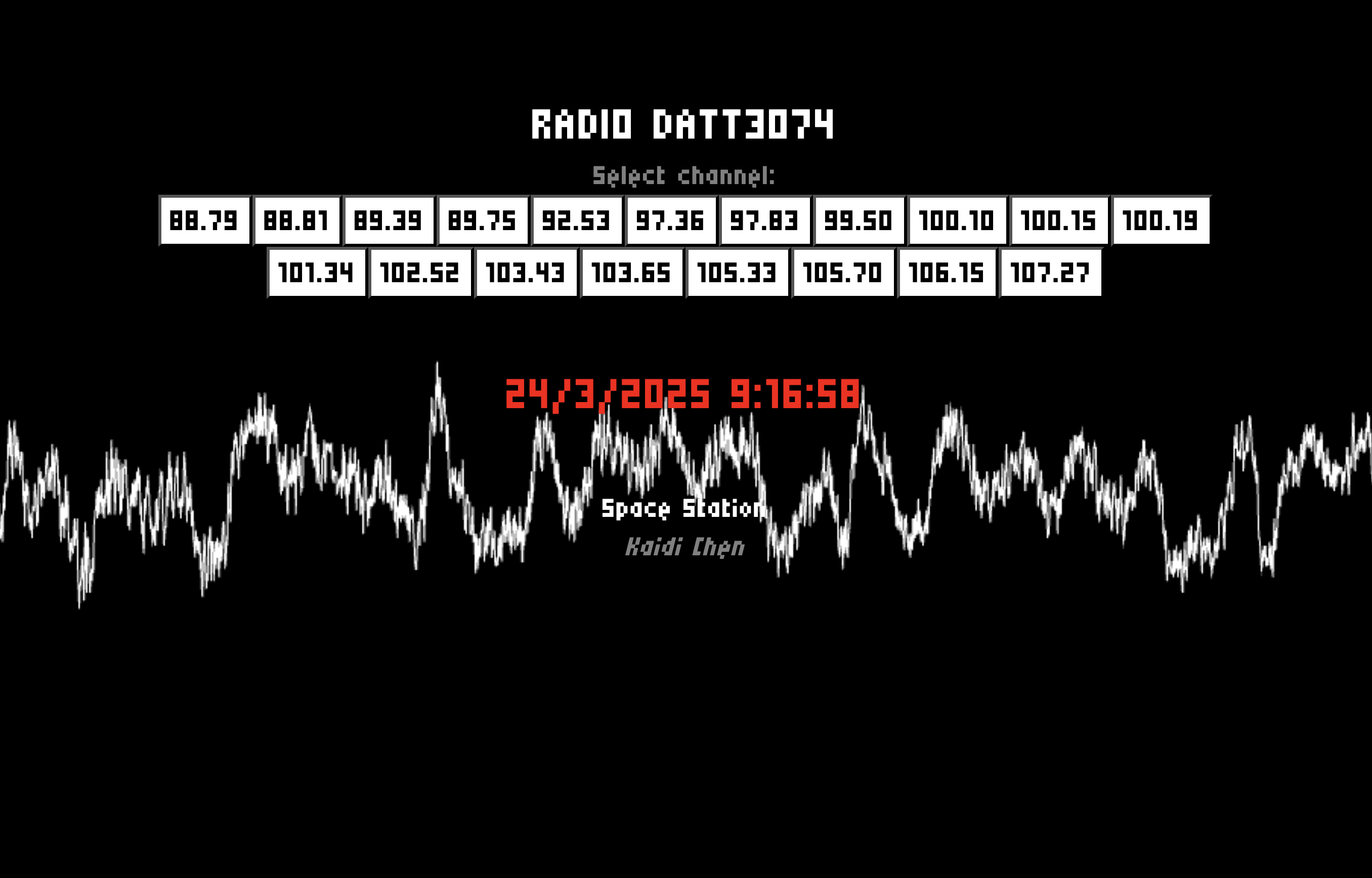
DATT 3700: Collaborative Project Development
Plight of the Kākāpō
Iman Syed, Anthony Dinadis, Julia Scheerer, Nicholas Yuille, Gareth Davey, Zaina Awad
Our project is an audio-visual experience meant to bring awareness to the decline and preservation of the Kākāpō, a species of flightless parrot from New Zealand. The primary means of conveying this message is through the projection of multiple pixelized frames of the Kākāpō onto a 3D printed model of itself. The pixelization is used to convey population, with 1 pixel equating to one Kākāpō, with the frames changing with the population. The video features a background that provides contextual elements that build a story of the various factors that have led to the Kākāpō’s decline. In these factors, the project holds the secondary purpose as a commentary on colonialism’s effect on native animal populations as virtually all factors that have affected the Kākāpō’s population can be traced back to it in some form. Additionally, the project features a soundscape that compliments the visuals on screen, varied levels of the multiple sounds are used to indicate the declining population of the Kākāpō along with the increasing prevalence of the various predators that contributed to it’s decline. To ensure the video and the model map well, the same 3D model used for the print is also the basis of the pixelized video. Additionally, the projector is lined up in a very precise manner in order to minimize the presence of the shadow on the backboard.
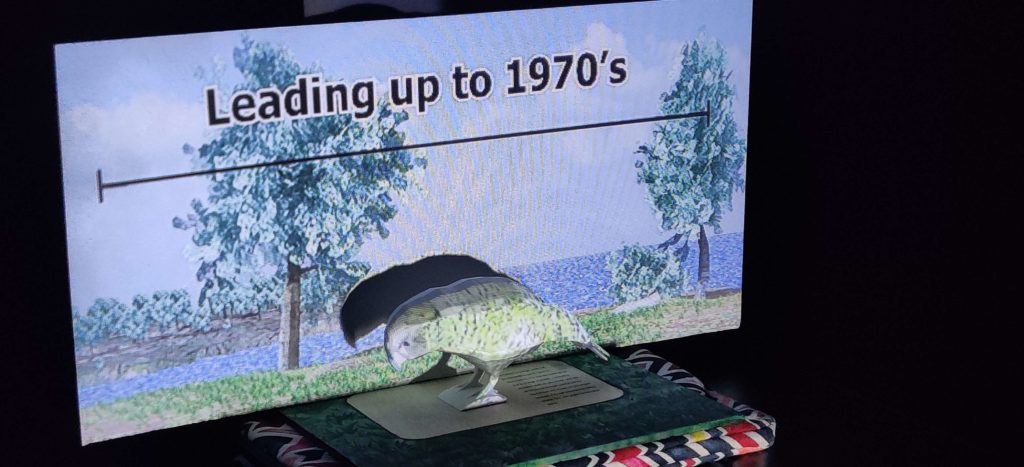
Kashechewan Flooding
Seila Bak, Robert Jamrocha-Tullo, Alyssa Campagna, Kayliah-Jayde Byfield, Kenzi Sulaiman, Chengxi Liu (Michael)
Welcome, our group created a hybrid data visualization in conjunction with a sculptural physical computing aspect that brings awareness to the ever-increasing flooding threat posed to the Cree people of Kashechewan, Ontario, exacerbated from the inaction of the Canadian government and worsening climate conditions. In the visualization, our team used an extensive data set of the monthly water levels from 1965 to 2020 using an interactive timeline for the audience to engage with, accompanied by the relevant water graphic animations. Coupled with the flood data, also on the visual display there are animated house icons with different stages to showcase the poor living conditions. As the viewer progresses through the timeline, they hear personal testimonies from the Kashechewan residents and witness dramatic subtitles of key words to emphasize their pain. These audio clips were implemented in the hopes of fostering empathy within the audience to the real-life community’s continued torment.
As for the physical portion, the viewer gently taps on the left and right photoresistor inside the eye-stencils to go backwards or forwards in the timeline. But with every tap, the audience indirectly covers the eye, representing the blindeye the Canadian government has turned to the people of Kashechewan. Finally, before the viewer stands a translucent 3D printed sculpture of hands reaching upwards, holding the Kashechewan sign above the rising and falling blue neopixels—that are synced with the flood data—showcasing their everlasting determination in the face of adversity.
It is our hope that this relatively small project brings the awareness the Kashechewan community rightfully deserves and to develop a meaningful dialogue between Canada and the First Nations communities; bringing empathy and humanity into technology and arts.
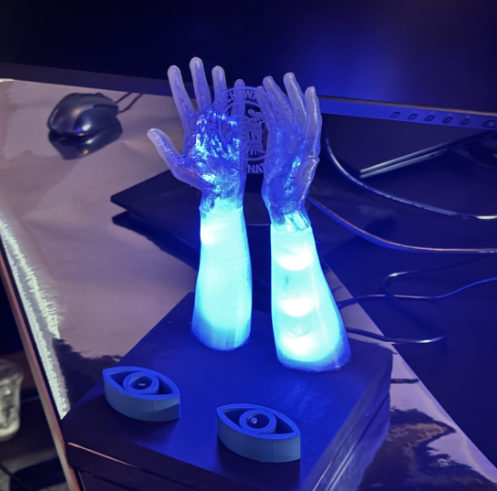
Outside-In
Hiromune Kubayashi, Yingni Chen, Duong Tran, Lielle Mammon, Robin Tarnocai
Since the Covid-19 pandemic, mental health disorders have increased in Canada, yet they remain heavily stigmatized. Our project aims to promote an open dialogue surrounding mental health, specifically helping viewers understand the experiences of people living with conditions at different ends of the spectrum of prevalence, anxiety and eating disorders. Using statistical and emotional data on eating disorders and anxiety we created this immersive multimodal sculpture.
On the outside of the sculpture, using NeoPixels, we displayed percentages of people who are over 15 years old that are affected by anxiety and eating disorders in Canada. This data includes statistics from 2012 and 2022, highlighting the impacts of the covid pandemic. Participants can interact with two distance sensors to change what year and disorder the statistics the neopixels display. As participants navigate the inside of the sculpture, they can explore the emotional impacts of anxiety and the eating disorder anorexia, through sound, visuals, Arduino sensors, and 3D fabricated objects that are paired together to embody each condition and their symptoms. When participants gain an understanding of the emotional experiences inside the sculpture, they can revisit the statistical data, understanding it from a place of empathy.
DATT 3701: Collaborative Project Development in Games
Date with the Devil
Sarah Miller, Jaylen Lie, Darshi Jani, Baila Hantsis, Lucas Bellotto
After a long existence in the mortal realm, you finally pass onto the afterlife. Now you can finally fulfill your dream of getting your long-awaited Date with the Devil. Satan has been your dream boyfriend since the moment you started having giggly crushes, and now you could do what you always wanted to do.
Unfortunately for you, you’ve ended up in the highest sphere of Heaven. Now you have to figure out how to get to your beloved as soon as possible, as you’ve waited long enough.
Cause chaos in heaven until the angels of that sphere are sick of you, and kick you to the lower level. Guess getting a Date with the Devil is harder work than you thought it would be!
Crowd Pleaser
Billy Abu Saleh, Strahinja Bastovanovic, Ethan Greene, Cassandra Hutchinson, Emily Terra
Time to Stand up! In this entirely new game made by Studio Stintendo! You are a struggling comedian trying to make it to the top of the entertainment world by making people laugh. However, you have stage fright and being in front of an audience scares you to your core. Despite that your dream compels you to overcome your fears and accomplish your dream! Crowd Pleaser consists of a variety of Minigames for you to play. Including some well known classics such as Rock Paper Scissors or Hangman, and some surprises that you may not see coming. However, every mini-game has a strict time limit that pushes you to complete it as fast as you can, and won’t stop at nothing to make you fail. So, do you have what it takes to wow the crowd, or will you succumb to your fears and never see your dreams come true.
Beneath The Skin
Duy (Jason) Tran, Vanessa Yu, Kobe Leung, Duy Nguyen, Wennan Zhang
Beneath The Skin is a short stealth and puzzle game where you play as an alien captured in a research lab. You possess the unique ability of being able to shapeshift into the humans around you. Your goal is to find your spaceship and escape the lab, all while trying not to get caught.
https://kobeleung.itch.io/beneath-the-skin
DATT 3935: Creative Data Visualization
Hidden Beauty of the Sky
Robert Jamrocha-Tullo
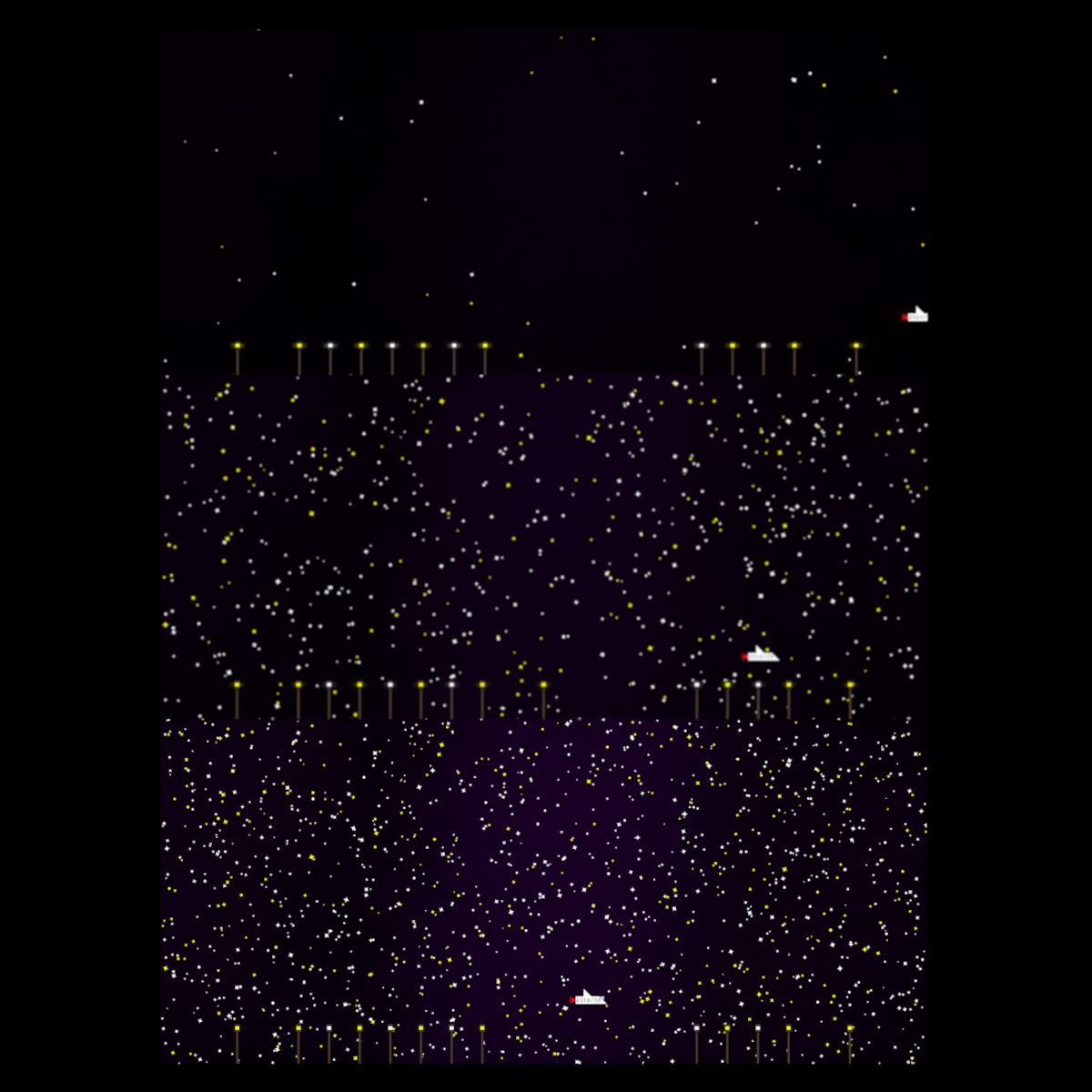
This piece is a computational data art animation made in p5.js. It visualizes light pollution data in Madrid, Spain, measured by the Complutense University of Madrid using a sky quality meter over 8 years. The animation paints a picture of stars in the night sky, through the use of procedural generation, which changes over time to match the sky quality data. When light pollution is high, fewer stars are visible on the screen, along with the background stardust being more transparent. When there is less light pollution, more stars will be visible, and the background stardust will become more opaque. There are also lamps at the bottom of the screen- these visualize street light data from the municipality of Madrid over the same time frame. The amount of lamps visible represents the amount of street lights in Madrid, and their colour denotes what kind of lamp they are- yellow for HPS, white for LED. To communicate the current time and progress through the animation, a spaceship will scroll by displaying the year and month. Immerse yourself with audio that matches the changes on screen, and mesmerize yourself with the twinkling of the evolving skyscape.
https://sihwapark.github.io/DATT3935_W25_Select_Works/Hidden_Beauty_of_the_Sky
Data Symphony
Yinqi Li
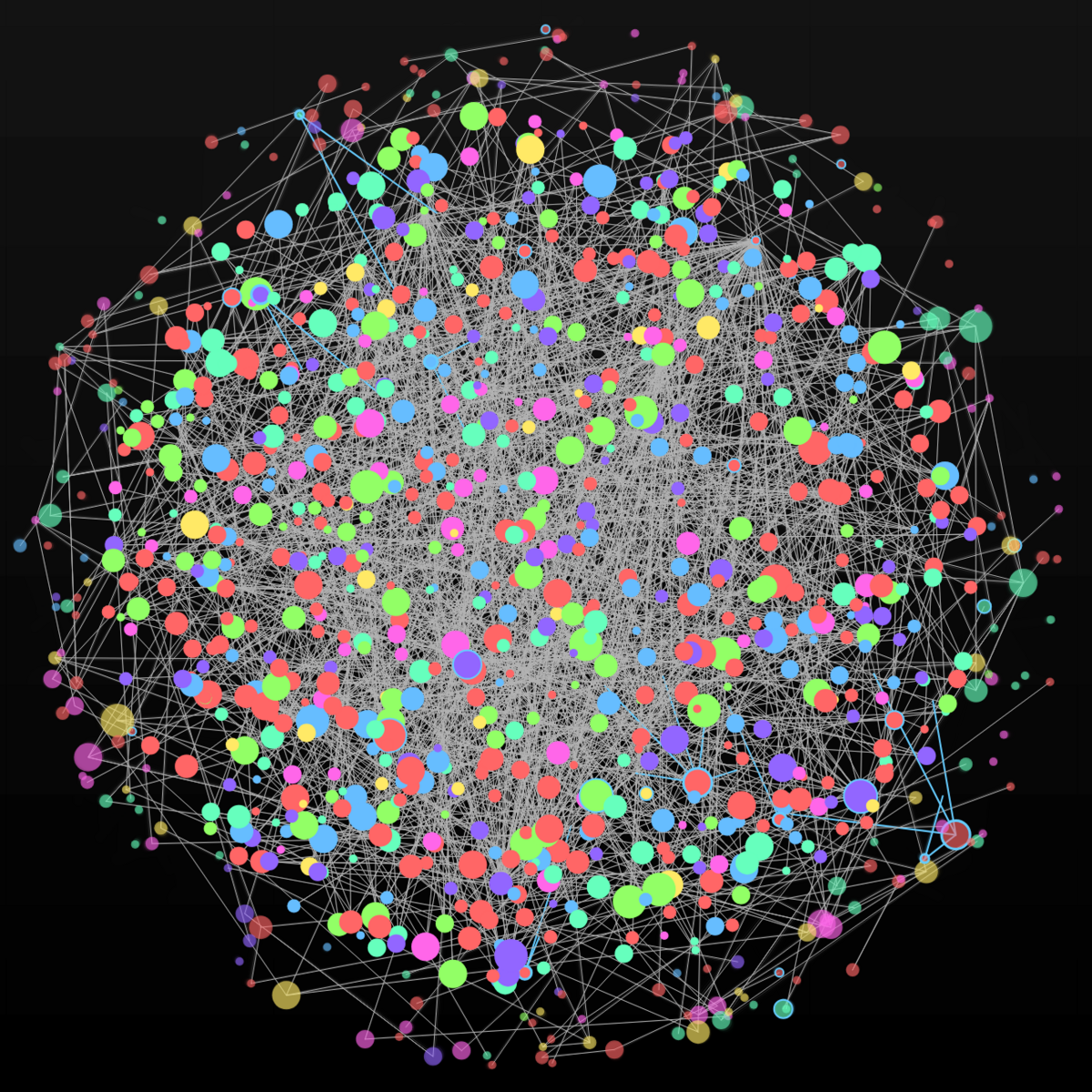
Data Symphony is a generative audiovisual installation that visualizes links to scholarly knowledge. Using the real-world Cora dataset, each paper inside becomes a blinking node, colored according to its research category and sized according to its impact. The center cluster pulsates like a living organism, while the peripheral nodes run on a regular trajectory of motion. When the audience clicks on a node to interact with it, it awakens hidden harmonies in the network. The tones are dynamically generated based on the structure and position of the nodes, constituting an evolving soundscape that blurs the boundaries between data and music. The system can also perform autonomously, creating an intellectual and aesthetic meditative dance.
https://sihwapark.github.io/DATT3935_W25_Select_Works/Data_Symphony
DATT 4600: Biomedia: Hybrid Art, Science and Computation
A Conversation between Roots
Elif Onem, Amenan Kouakou
This work explores the subtle yet essential relationship between a plant and a fungus — a symbiosis rooted in communication, collaboration, and mutual support. While this biological exchange is often hidden from view, it shapes the foundation of terrestrial ecosystems. Inside a Petri dish, arbuscular mycorrhizal fungi (AMF) were introduced and allowed to begin establishing their hyphal network. A few days later, catgrass seeds were added. Over time, the plant and fungi began responding to each other’s presence. Although imperceptible at first, under the microscope, fine fungal threads could be observed clustering near the root hairs — an early stage of connection.
This interaction reflects a deeper theme: communication between organisms, both seen and unseen. Despite their differences, the plant and fungi adapt not in isolation, but through shared signals and nutrients. This mutualism is one of nature’s most enduring strategies — a quiet alliance between species that cannot survive alone.
The second layer of the work emerges through interactive code. A live camera feed captures the microscopic view, and a custom program written in p5.js allows viewers to click on visible fungal structures. Upon interaction, a green line begins to trace the fungal thread — mimicking the way fungal hyphae grow and explore, following chemical cues from plant roots. What began as an organic process continues as a digital path, extending the biological into the virtual.
By translating this natural connection into a visual and interactive form, the work invites reflection on interspecies relationships, unseen networks, and the importance of support systems — especially those often taken for granted. It asks: how do organisms reach toward one another? What does connection look like before it fully forms?
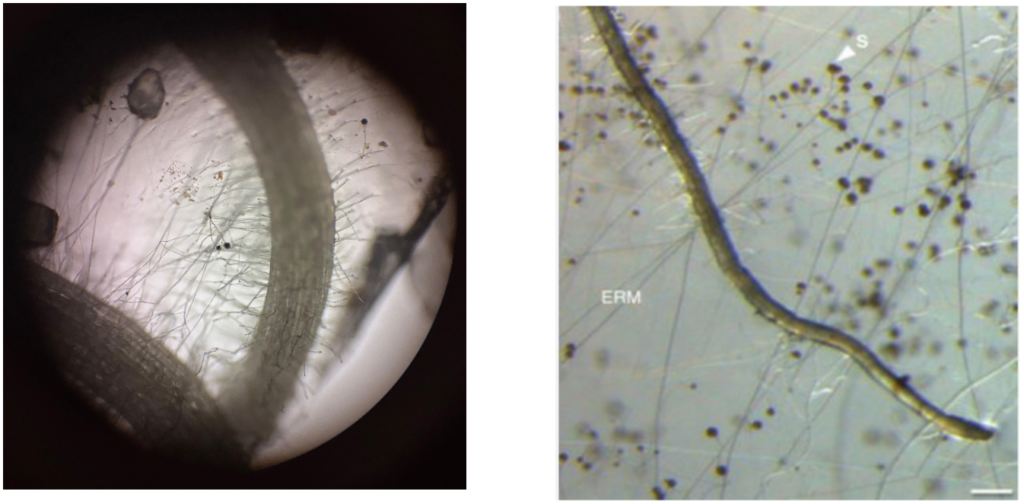
Petree Dish
Lielle Mammon, Hana namdar, Shadi Karimpour
Petree Dish is an experimental work in which we aimed to visualize the path the single celled organism slime mold would take when introduced to different drugs. We began by growing slime mold in a regular petri dish, observing its behavior with its favorite food, oat flakes. We had an unexpected observation; our petri dish began to grow mold and the slime mold moved around and away from the mold. As the mold grew to cover the majority of the dish, the slime mold had moved all the way to the edge of the petri dish, trying to escape from the mold. This was insightful as it allowed us to understand that slime mold not only has an interest in certain things, but also repulsion.
With the slime molds reaction to mold in mind, we began the process of introducing the slime mold to different drugs. We used a 3D printed tree to host our slime mold, a reference to slime mold liking rotting wood, and acting as a more visually interesting petri dish. We placed slime mold in the center of the base of the branches and crushed up children’s Advil on one branch, GABA powder on the second, and CBD oil with a small amount of THC on the third.
The results were quite interesting. The slime mold grew on the branch with the CBD, tried to grow on the Advil branch, but then took a different path after it was not enticing/or perhaps repulsed, and had no interest to go towards the branch with GABA. We used LEDs with different brightnesses to indicate how much the slime mold interacted with each substance. The green light represents CBD, white for GABA, and red for Advil.
This project allowed us to gain insight about slime mold and its interactions with substances that humans commonly interact with, creating a sense of familiarity and intrigue.

DATT 4933: Life Centred Futures: Sustainability, Interaction Design, and AI
Resonance & Responsibility: The Sustainable Impact of Headphones
Sneha Vijayakumar, Saneea Khalid, Lisa He
Our project focuses on the negative impacts and harm the production process of headphones have on humans, animals and the environment. To portray this message we created a video that starts off slow and dramatic then begins picking up pace to end on a light hearted and catchy song. We came up with the lyrics for the song at the end of the video and it’s based on “Dumb Ways to Die” by Tangerine Kitty, which discusses Life-Centered Design and making the world a better place. We each took responsibility for researching and exploring a single persona – ecosystems, non-humans i.e. animals, birds, etc, and humans – to showcase the impact of the headphone production process on each of them. The purpose and goal of exploring each persona is to address the social, political, ecological and various other problems the process has that negatively impact everyone.
EECS 4700: Digital Media Project
Cattleman’s Crossing
Riordan Palmer, Shana Isaac, Raju Sivanantham, Delvin Salman, Tarek El Jarab
After a long life as a cowboy, Wayne lives alone on his cattle farm haunted by a
tumultuous life. When a mysterious visitor arrives with a warning, Wayne decides to embark on one last cattle drive before the end. Join Wayne and herd cattle across the beautiful Canadian wilderness as he reflects on a life full of pain, love, and loss.
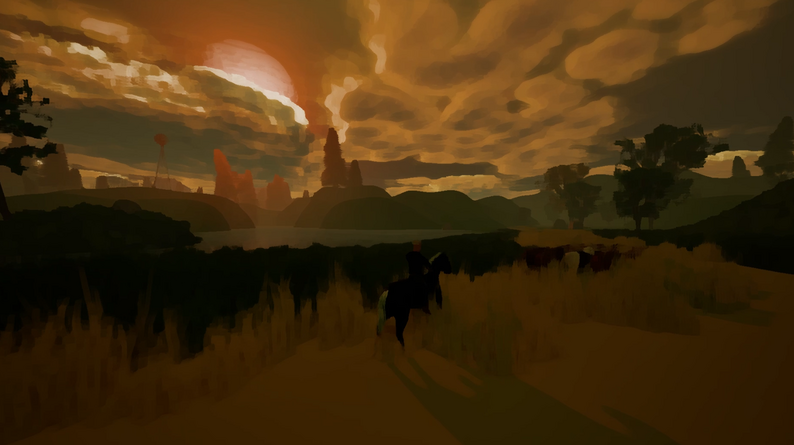
Cattleman’s Crossing began with the vision of providing a fresh take on the western genre. We sought to move away from explosive gunfights and problematic subject matter, instead using the genre’s iconic tropes to tell a more grounded and emotional story. Built in Unreal Engine, the game uses unique processing effects to create beautiful, painted representations of real Canadian environments. With simple and atmospheric herding gameplay, we want players to immerse themselves in stunning landscapes as they uncover a heartfelt story unlike those traditionally offered by the frontier.
BLOOM
Kaitlin Urlando, Sarika Patel, Prachi Sadhwani, Muntaha Begum, Laura Logan
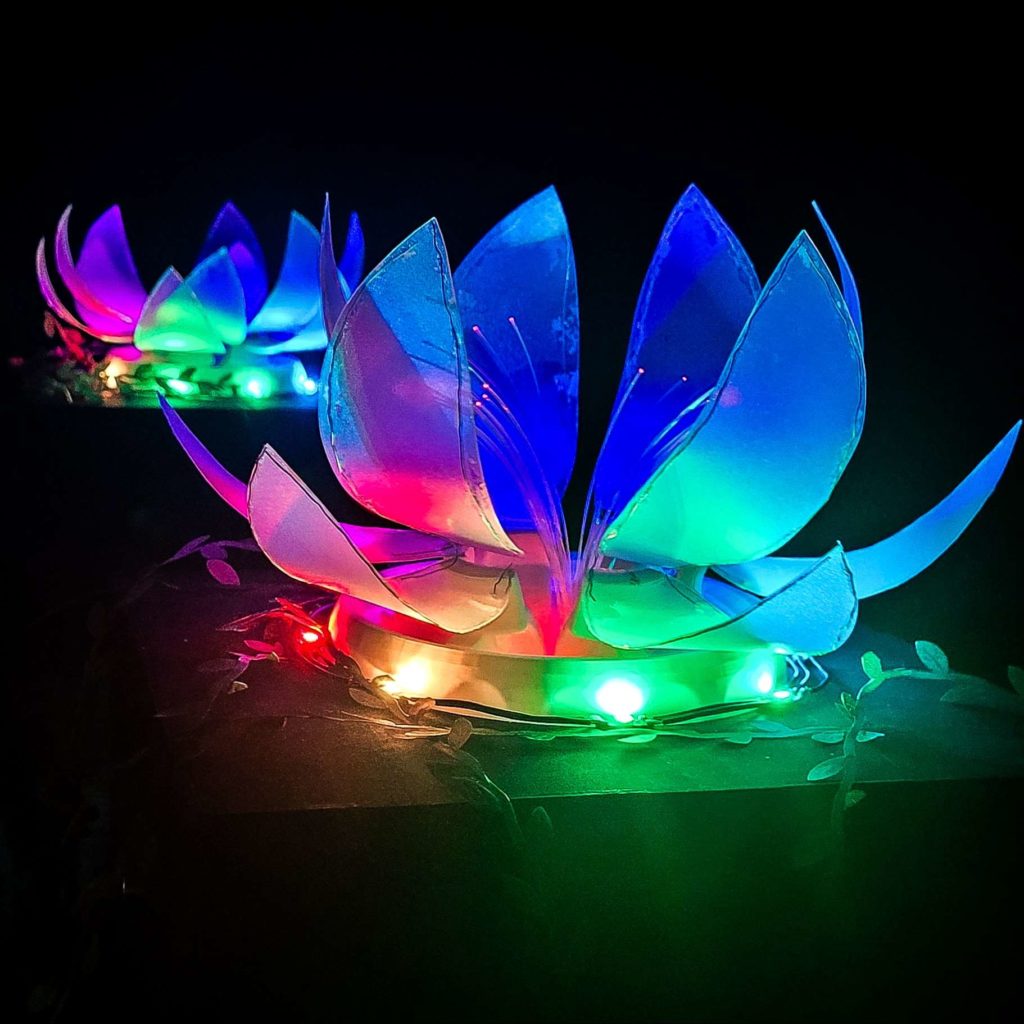
BLOOM is an interactive installation that explores defense and communication in plant life through mechanical mimicry. Inspired by the reactive movement of the mimosa pudica and the mimicry of the bee orchid, the piece features two robotic flowers that respond to human presence. When a viewer approaches, one flower closes and signals the other to do the same. If someone steps in front of the second flower, it flashes white, sending a warning that prompts the first to flash in return. Through this exchange, BLOOM reveals the subtle, often unseen survival strategies of plants, translating natural behaviours into mechanical responses and inviting viewers to consider the ways living organisms communicate with each other.
DIGM 5020 6020: Vertical StudioLab
THE GAME
Christina Mazza, Maximus Lam
A video game.
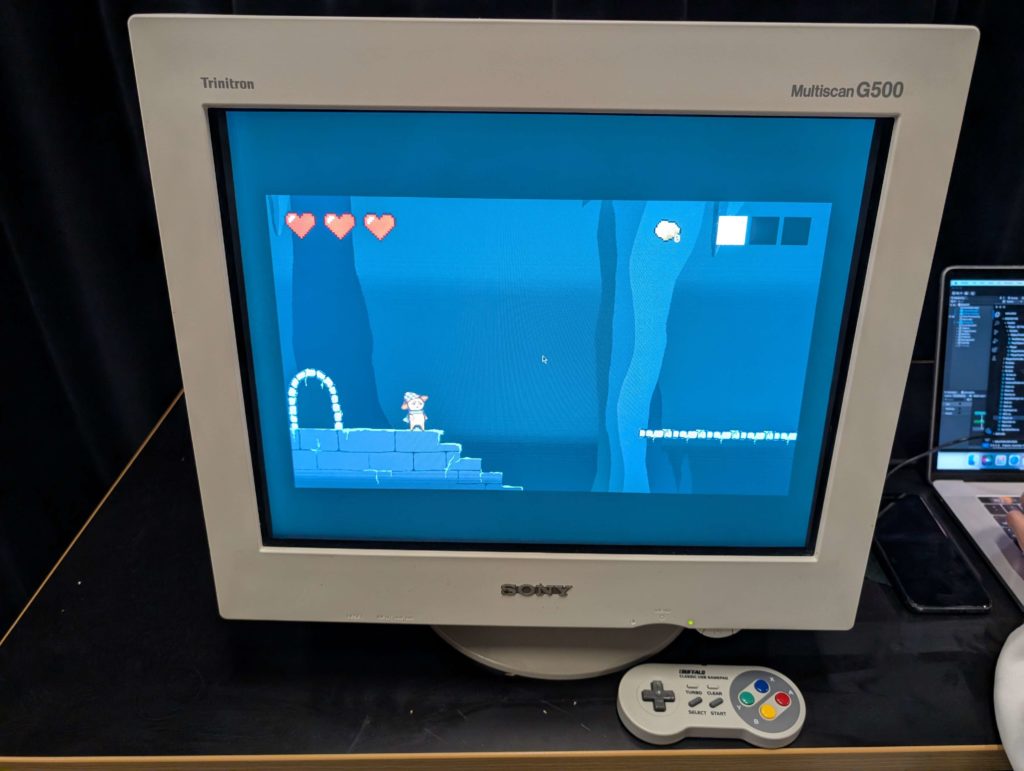
Image Forming Apparatus
Jubelle Paa, Shelby Murchie, Qianhua Liu
This work was initially inspired by abandoned USPTO Patent 6483603, which shares the same title. The artistic repurposing of e-waste materials gathered through secondhand means applies media archaeology concepts, particularly in the assertion of great value in forgotten and obsolete media. Old electrical wires, VHS tape, and severed parts of obsolete electronics are weaved into a tangible web held together by crochet stitching techniques.
A projection onto the structure consists of an abstract heatmap animation of global e-waste levels. The work is also interactive–visitors can walk under the piece and touch pieces of a disassembled portable DVD player. Capacitive sensors allow the piece to respond to touch with echoing sounds of people using the technology for its original function.
The work contrasts mass-produced, ephemeral, ever-changing electronic media with the slow, repetitive, personal process of crochet technique. It compares the relationships that both crochet craft and technological media have between domesticity and the ability to hold memory.
Touchstone
Marko Cindric, Thalia Godbout, Rachel Remesat
As digital technologies converge upon capacitive glass as the interface du jour, diversity in the tactile field collapses. Our project draws inspiration from speculative design to imagine new interfaces that recenter the experience of touch as a richly exploratory, relational, and sensual act. The materiality of the interface is accentuated, posited as a site of attentive curiosity, rather than treated as a necessary inconvenience on the path to task completion.
Touchstone invites people to explore, caress, and embrace its textured body and cushiony surfaces. Crafted from paper mâché and repurposed textile scraps, the sculpture contains embedded capacitive sensors that sense participants’ touch and presence, interfacing with real-time granular audio synthesis designed to synesthetically emphasize textural properties (i.e. roughness, friction).
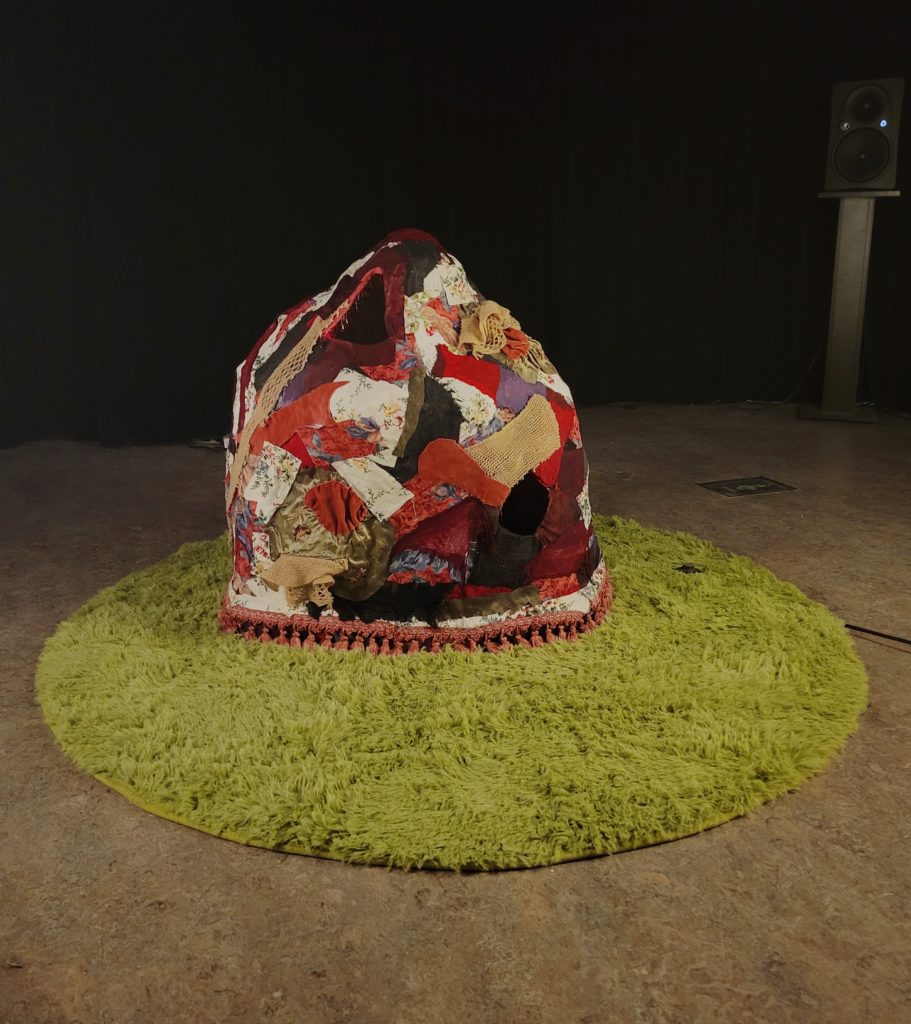
The Séance
Kyle Duffield, Zhino Yousefi
The Séance—an AI-driven immersive fiction performance that transforms physical space into a ritualistic encounter with obsolescence, memory, and technological afterlives. At its core is a 1990s computer tower, which contains the compressed consciousness of its owner —John, a researcher at NecroLink Technologies who mysteriously vanished. To retrieve this data, participants must participate in a séance and enter conversation with a mountable mind known as John.iso.
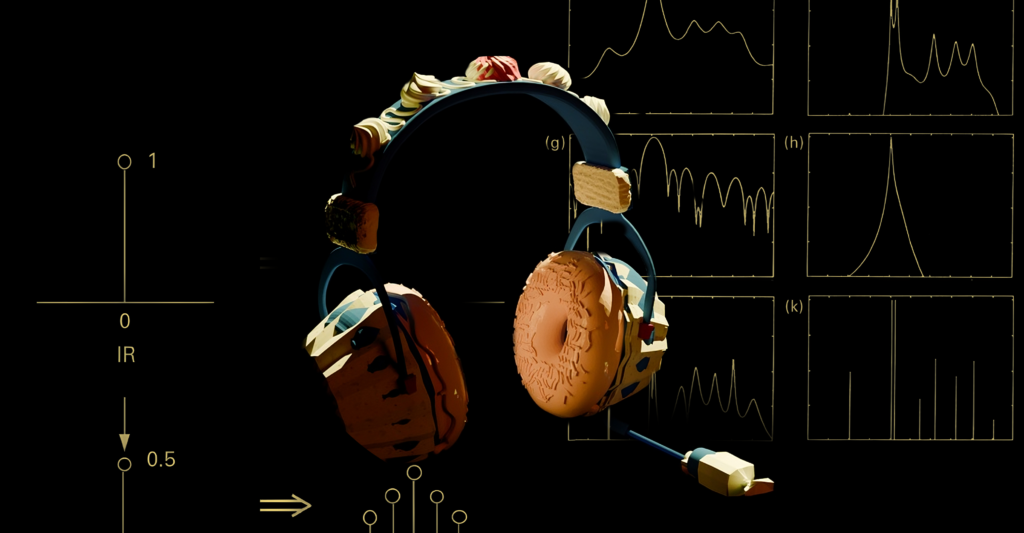
For inquiries regarding this initiative, please contact:
Digital Media Program
School of Art, Media, Performance and Design
York University, Toronto
4700 Keele Street .:. 228 Goldfarb Centre for Fine Arts .:. Toronto ON, M3J 1P3
http://computationalarts.ampd.yorku.ca/
https://lassonde.yorku.ca/academics/digital-media


